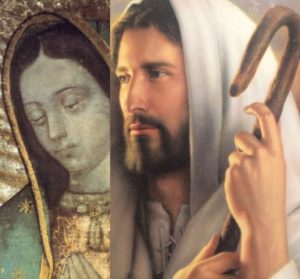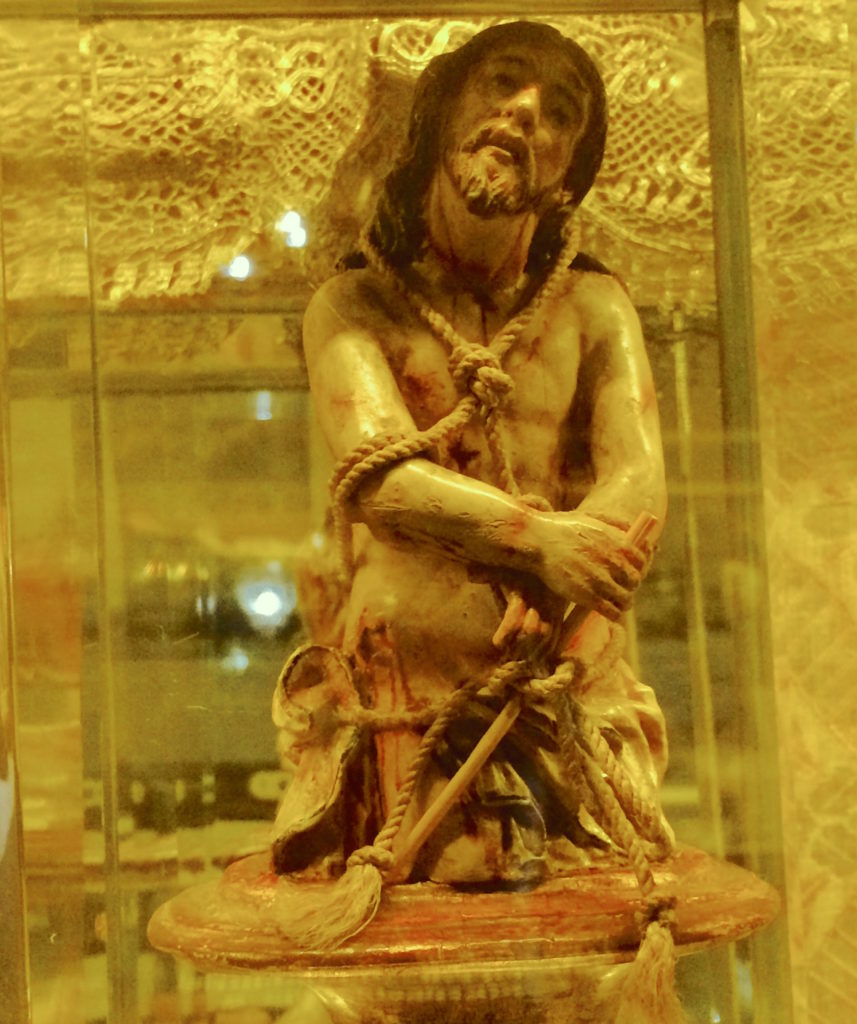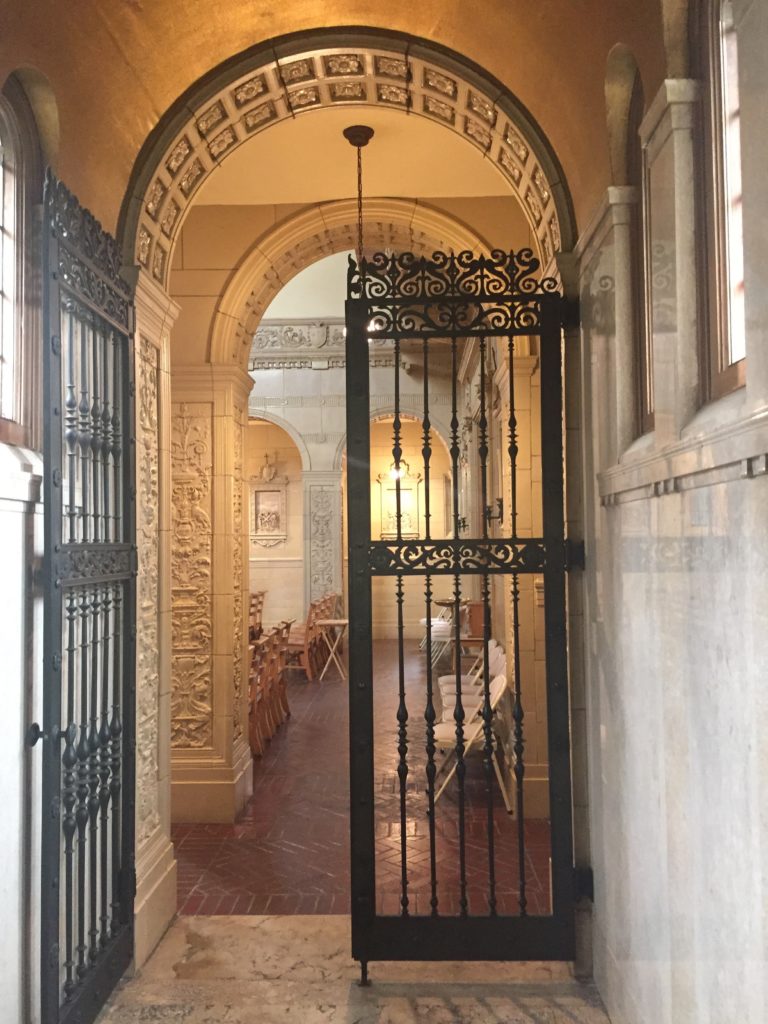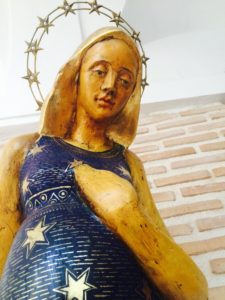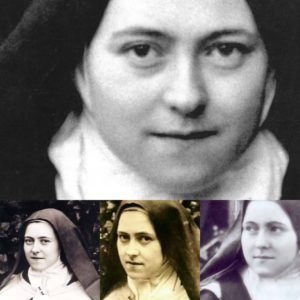
A reading of the Holy Gospel According to Luke: Jesus said to the Pharisees: “There was a rich man who dressed in purple garments and fine linen and dined sumptuously each day. And lying at his door was a poor man named Lazarus covered with sores, who would have gladly eaten his fill of the scraps that fell from the rich man’s table. Dogs even used to come and lick his sores. When the poor man died, he was carried away by angels to the bosom of Abraham.The rich man also died and was buried and from the netherworld where he was in torment he raised his eyes and saw Abraham far off and Lazarus at his side. And he cried out: “Father Abraham have pity on me. Send Lazarus to dip the tip of his finger in water and cool my tongue for I am suffering torment in these flames.” Abraham replied: “My child, remember that you received what was good during your lifetime while Lazarus likewise received what was bad. But now he is comforted here whereas you are tormented. Moreover, between us and you, a great chasm is established to prevent anyone from crossing who might wish to go from our side to yours or from your side to ours. He said: Then I beg you father, send him to my father’s house, for I have five brothers so that he may warn them lest they too may come to this place of torment. But Abraham replied, “They have Moses and the prophets. Let them listen to them.” He said, “Oh no Father Abraham. But if someone from the dead goes to them, they will repent. Abraham said: “If they will not listen to Moses and the prophets, neither will they be persuaded if someone should rise from the dead. The Gospel of the Lord
This very strong reading is a good example of how ‘the gospel comforts the afflicted and afflicts the comfortable.’ You’ve heard that expression before, I am sure. What do we mean by the comfortable? The comfortable, in this context, means the complacent. The complacent are those who are indifferent to the legitimate needs of others around them. The warning we heard about in the first reading from Amos to the complacent in Zion, is to those who didn’t care about or who were insensitive to those who are suffering.
In the commentary in the Magnificat, Cardinal Christoph Schonborn, who is known for editing the Catechism of the Catholic Church, says that “carelessness or self-centeredness is what blinds a person to our neighbor’s need. The rich man in the gospel, who feasts sumptuously, was perhaps not even deliberately cold to Lazarus, who was lying at his door. But rather, he had grown accustomed to seeing him there. His wealth and comfortable life made him insensitive to the suffering of his fellow man around him.”
This complacency is an expression of hardness of heart. Cardinal Schonborn later says, “And the hardness of heart is in itself a choice of rebellion towards God.” Someone who hardens his or her heart against his or her neighbor has rebelled against God. That echoes and reminds us of the passage of The Last Judgment in Matthew 25: ‘What ever you did to the least of mine you did to me.’
This passage was so close to the heart of Mother Teresa of Calcutta who made her whole life mission to be that of picking people up out of the gutter. She didn’t only pick people out of the literal gutter, in the sense of the slums, but out of the gutter of any depression. She picked people up out of the sorrow of feeling unlovable. She went out and reached out to those who were most in need and who felt unloved. St. Thérèse is a great prophet of Merciful Love, and she was one of the great inspirations of Mother Teresa of Calcutta and after whom Mother Teresa received her name.
I want to refer to the book by Father Michael Gaitley: 33 days to Merciful Love: A Retreat With St. Thérèse. This book is his sequel to 33 Days to Morning Glory, one of the most popular ways of consecrating ourselves to the Immaculate Heart of Mary and to live a life committed to Jesus Christ. Gaitley made the Total Consecration to Mary, as originally authored by Saint Louis de Montfort, and presents it in a new, more modern tone. Saint Louis de Monfort’s style is older and similar to The Imitation of Christ. Both works are solid and grounded but sometimes very difficult to digest by our post-modern ears.
The first idea from Fr. Gaitley is in regards to how we relate to St. Thérèse. Father Gaitley rightly points out that St. Thérèse doesn’t always make a great first impression. In fact, he says “I’ve often heard that when people first meet her in her writings, they think ‘I can’t relate to her.’ They say, ‘What do I have in common with a girl who grew up in sheltered home, lived in a cloistered convent and died at just 24 years old?’ But then as they get to know her more they will often say, ‘I relate to her more than to any other saint.'”
I’ve found that to be very, very true not only in my own life but in those of many others.
Father Gaitley continues to say, “We relate to Thérèse because she is real. She is not a plaster statue high on a pedestal. In fact, we get the sense that she is right down here in the grittiness of ordinary life with the rest of us. During her life she wasn’t famous or well known. Indeed, her time in the convent truly was a hidden life full of the daily darkness we all experience. Yet, she is a great saint. But her stand-out sanctity is that she did little things with great love.” Mother Teresa’s mantra: ‘Do great things with great love’ came from St.Thérèse, and even Saint Teresa of Avila said the same thing, as all the saints do.
Father Gaitley writes, “Yes, in the midst of an ordinary mundane life she had extraordinary faith, hope, and love that are accessible to us all. As St.Thérèse herself put it, ‘Why should this treasure not be yours?'” – namely the treasures of faith hope and love. In the midst of ordinary and sometimes mundane life, we must allow ourselves to do little things with great love. Doing so allows the great love of Jesus into our hearts, so that He becomes our primary inspiration and motivation that sustains us. Finally, Father Gaitley says about Thérèse, “like most of us she not only knew herself to be weak and imperfect, but she also knew what was like to live in an age of secularism and doubt.”
This reminds me of the rich man’s response in the gospel. The rich man says, ‘This is so terrible. Please Abraham, do me a favor. Send somebody to my brothers because my brothers are just as bad off as I was. Send somebody from the dead who will shake them up, wake them up and scare the hell out of them’ so to speak. ‘They really need a good rattling in order for them to wake up.’ Abraham responds ‘Even if someone were raised from the dead, if they did not listen to the prophets, they would not be moved.’
Who was raised from the dead? Jesus. This story is about believing in the resurrection of Jesus. If someone isn’t willing to settle in simple faith to the truth of what was spoken by God’s prophets, then scaring them into faith isn’t going to work.
Faith comes alive and is awakened by attraction, not by fear or by hell and brimstone. Faith is awakened by Love. And if people are not attracted to it by Love, then throwing fear upon them isn’t going to last.
Think about a horrible time in our history, for example, the tragedy of 9/11. After 9/11, there was a phenomenon of churches being full because people were shaken up. They returned to their faith, whatever faith they came from, and for a time, churches had tremendous attendance because of the fear that woke our nation up. In all likelihood, most of the people who came back to church just because of the tragedy did not attend church for too long out; fear isn’t enough to produce a faith that bears fruit that lasts. It has to be motivated by something deeper. That is: the love of God.
Abraham tells us to listen to Moses and the prophets. St Thérèse of Lisieux is the great prophet of modern times, the prophet of Merciful Love. Thérèse’s legacy, as Father Gaitley points out, is that “She speaks to us in a fresh way about the heart of the gospel” which is the heart of Jesus, the heart of God. That heart of the gospel, that truth, is what sets us free to be fully who we were each meant to be in God’s plan for our lives personally.
As our Catechism says, the heart of the gospel “is the revelation in Jesus Christ of God’s Mercy to sinners.” Very simply: the revelation in Jesus Christ of God’s mercy to sinners. Father Gaitley points out that “The good news of God’s mercy for sinners is that God doesn’t love us because we are so good, because we are good enough, or because we’ve earned to be loved by God.” God loves us not because we’re so good but because He is so good. The good news is God loves us not because we deserve it, but because we desperately need it.
This is Divine Mercy. This is the gospel. (to be continued).
Saint Teresa of Calcutta, Saint Thérèse, and all Carmelite Saints, pray for us.
(SOURCE: San Rafael, CA Novena, September 2016) Thérèse 3- transcribed by Linda Dorian
Copyright 2016, Fr. Robert Barcelos. All Rights Reserved
‘Arm yourselves with the armor of faith and the sword of truth. Pray for the grace to forgive and to ask for forgiveness – and for the healing of wounded bodies and souls.’
[sbscrbr_form]

